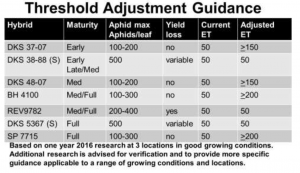2016 Research Project–Final Reports
Sugarcane Aphid on Sorghum in South and Central Texas
Principal Investigator– Michael Brewer
To read the final report, click here.

Development of a Decision Aid for Control of the Sugarcane Aphid in Grain Sorghum after the Initial Insecticide Application
Principal Investigator–Pat Porter
To read the final report, click here.
When to trigger a second application for sugarcane aphid:
Research at Lubbock, Halfway and Bushland examined the yield loss that would be caused by sugarcane aphids if the first control attempt failed or could not be implemented. Yield loss in susceptible sorghum was 2,900 to 4,000 lbs./acre, while yield loss in a resistant hybrid grown with more irrigation was 1,230 lbs. A leaf damage rating scale was developed, and data suggest that the top 50 – 60% of the canopy must be protected in order to avoid excessive yield loss. Given the rapid population increase potential of the sugarcane aphid, we recommend applying insecticide no later than when the bottom 20% of leaves are damaged and active aphid colonies are present.
Demonstrating Grain Sorghum Potential in Texas: Using Best Management Practices to Maximize Yield and Economic Return
Principal Investigator–Ronnie Schnell
To read the final report, click here.
Assessing the impact of planting date, insecticide seed treatments, and resistant varieties of sorghum on timing and severity of SCA infestations in Texas High Plains
Principal Investigator–Ada Szczepaniec
To read the final report, click here.
We evaluated how planting date (early – May 11, common – June 23), hybrids (susceptible – DKS44-20, and tolerant – DKS37-07), and insecticide seed treatments (with and without Poncho®) affected sugarcane aphid numbers and yield. We used the 50-125 aphids/leaf as threshold and foliar insecticide (Sivanto®, 4 oz/A) applications were triggered when aphids reached these numbers. We report that:
- Within 2 weeks of colonization, aphids on susceptible hybrids reached the threshold, while aphids on the tolerant hybrids reached threshold within 3 weeks.
- Aphids were successfully controlled for 3-4 weeks when foliar insecticides were applied at 50-125 aphids/leaf.
- Insecticide seed treatments lowered aphid numbers in sorghum planted at the common planting date, but not in early-planted sorghum.
- Seed treatments did not affect yield and yields of the tolerant hybrid were comparable to yields of the susceptible hybrids when aphids were sprayed. When aphids were not sprayed, the tolerant hybrid out-yielded the susceptible hybrid.
We conclude that intense scouting in late July and early August is very important and foliar insecticide treatments may be needed within 2 weeks of colonization for susceptible sorghum and within 3 weeks for tolerant hybrid. Aphid numbers in tolerant hybrid increased slower and this may be very helpful in timing foliar sprays before aphids start increasing exponentially, at which point it is nearly impossible to control them.
Dryland Grain Sorghum Trials in the Texas Panhandle and South Plains
Principal Investigator–Calvin Trostle
To read the final report, click here.
Among 4 planted hybrid trial sites one made it to harvest, our sister NMSU-Clovis trial (avg. yield 4,414 lbs./A). Top yielders were Pioneer 85P05 (5,913), Channel 6B60 (5,889), Sorghum Partners KS 585 (5,818). All sites seeded at 29-32K seeds/A. Like past trials, as a group medium maturity hybrids (4,765 lbs./A) out-yielded medium-early (4,384) & early maturity (3,822). Agri-Life has long suggested in the TX High Plains planting a medium-early late may be favorable for increased yield potential vs. early frost risk compared to early maturity hybrids and lower yields.
Here are hybrids 11 companies, given a choice to enter only two hybrids, selected for TX High Plains dryland (maturity group & *company cited as potential sugarcane aphid tolerant).
Advanta: AG1201* (early, E), AG1101 (early) Hoegemeyer: 6020* (ME), 671* (M)
Channel: 5B90* (medium-early, ME), 6B60 (ME) Pioneer: 85P05 (M), 87P20 (ME)
DynaGro: M60GB88 (medium, M), M60GB31 (M) Richardson: RS215 (ME), Swift* €
Dekalb: 37-07* (ME), 44-20 (M) Sorghum Partners: KS585 (M), SP34A19 (ME)
Frontier: 279* (ME), 305C* (M) Warner: W-625-Y (M), W-632-W (M)
Golden Acres: 3960B* (M), H-390W* (ME)

